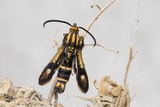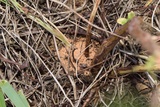Chamaesphecia nigrifrons (Le Cerf, 1911) Species
Last modified: June 5, 2025, 3:10 p.m.
In Belgium, this species was mentioned for the first time in 2018 in 'interessante waarnemingen' (remarkable observations) in Phegea 46/2 but the detailed publication was published in 2019 (Garrevoet T., Goossens R. & Meert R. 2019). Ch. nigrifrons presumably migrated from the south into Belgium in the second decade of the 20st century.
Details
- Classification
- Family: Sesiidae > Subfamily: Sesiinae > Tribus: Synanthedonini > Genus: Chamaesphecia > Species: Chamaesphecia nigrifrons
- Vernacular names
- Hertshooiwespvlinder (NL), Sésie du Millepertuis (FR), Johanniskraut-Glasflügler (DE)
- First mention in Belgium
- Steeman C. & Sierens T. 2018. Interessante waarnemingen van Lepidoptera in België in 2017 (Lepidoptera). — Phegea 46(2): 31–47. On page 44.
- Status
-
Native
Distribution
Imago
Ch. nigrifrons is a small species but nevertheless variable in size (10–18 mm). The forewings are dark brown and irregularly strewn with yellow scales. The external transparent area is small, round and consists of 3–4 cells. Between head an thorax there is a striking yellow-brown collar of pericephalic hairs. The thorax is black and has the tegulae bordered with yellow scales apically. The abdomen has white to yellow bands on segments 4 and 6 (and also on segment 7 with the males). The hind legs have black tibia with a conspicuous grey-yellow distal part. The proboscis is well developed and functional.
The males are fairly well attracted to the pheromone developed for S. tipuliformis and are best lured in late morning and early afternoon but, as always, the optimal time span is very weather dependent.
Egg
The egg is dark brown and elliptically shaped.
Mine
The caterpillar constructs a gallery in the root of the hostplant and eventually also in the lower part of a stem to prepare the hatching site.
Bionomics
The female deposits the eggs on the stem of Hypericum species and seems to prefer slightly thicker stems. The just hatched caterpillars bore directly into the stem and migrate to the base of the stem. There they feed on the sap of the plant and start ejecting frass, initially small amounts, but later, from August onwards, the amount of frass becomes quite impressive, especially for such a relatively small caterpillar. This is most likely due to the fact that, in the meantime, the caterpillar also gnaws inside the root, often almost to its point. The typical reddish-brown colour of this frass makes that infested plants are very easy to find during this period of the year.
Later, in autumn, the caterpillar makes a circumferential cut in the already hollowed-out stem. This can be very close to the bottom but just as well at a height of 15 cm or even more above ground level. This can also depend on the density of the surrounding vegetation. Just below this circular cut, the caterpillar constructs a dome-shaped plug in the stem itself consisting of small plant grains and spun silk. All this weakens the stem so it breaks down very easily, often in fall. But winter storms and especially the weight of any snow ensure that the majority of the stems are broken down by early spring. Also at this moment the species is still fairly easy to find: the stems without a caterpillar inside are all still upright but the stalks hollowed out by the caterpillar are broken down between the vegetation, usually near the plant from which they originate. When the fracture surface is checked, it is immediately noticeable that it is pretty straight and smooth because it was prepared by the caterpillar. Stems that have broken down for other reasons invariably have a very irregular fracture surface. The remaining piece of stem that remained on the plant is also not that hard to find because the spun dome is now clearly visible. The frass, so striking in early autumn, is often still visible but has already faded and is discoloured yellow. The caterpillar lives withdrawn in the root during the winter and early spring.
The pupation then follows somewhere in the second half of April or the beginning of May. No cocoon is constructed and so the pupa can move freely in its gallery. The hatching happens quickly and usually in the morning hours. The pupa pierces the last barrier to the outside world, in this case the spun dome, works its way out halfway and hatches. The empty exuvium remains stuck for some time until wind and weather or another external reason causes the exuvium to either break off or fall out of the stem.
So the development of Ch. nigrifrons is completed in one year.
Flight periods
The main flight period is from mid-May to the beginning of June but is, which is not strange for a spring species, highly dependent on the weather conditions.
Observed on
- Host plant (species):
- Hypericum perforatum and Hypericum hirsutum
- Host plant (genera):
- Hypericum
Ch. nigrifrons lives on Hypericum spp., especially H. perforatum –the host plant most frequently mentioned in the literature– and also H. hirsutum. But the species was also found in H. maculatum and H. tetrapterum.









































